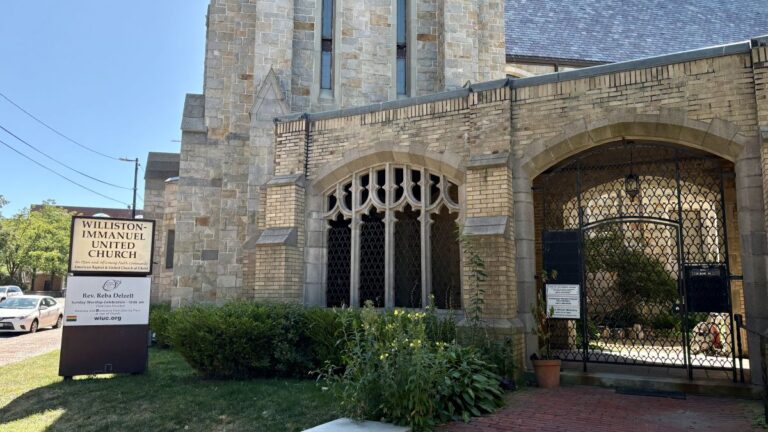Once a thriving lumber community that dates back to the late 1700’s, the humble town of Dennysville in far Downeast Maine now could be easily overlooked. Travelers zip along US Route 1 on their way to busier, more prosperous places, such as the City of Calais, fifty minutes farther east at the Canadian border.
But wander left onto Route 86 and you’ll find the quaint town of Dennysville and its 326 residents tucked away on hilly residential streets that meander along the Dennys River, and ramble to the Cobscook shore. Majestic snow-laden pines, rippling streams, and historic buildings create a picturesque scene not unlike a Currier and Ives painting.
“A historian visiting here once said Dennysville is like a fly in amber, frozen in time,” said Ronald Windhorst, president of the Dennysville Historical Society and pastor of the Dennysville Congregational Church.
That obscurity, along with a dwindling population — down 34 percent over the last ten years — and harsh economic times, provide limited resources for sustaining town services. A $7 million estimate last year for crucial road repairs was just the most recent hit.
The town has $88,000 in its budget of just $450,000 of appropriations to cover all road expenses. The disparity, coupled with other drains on the coffers and ever-higher taxes, led Dennysville’s town officials to make a tough decision — recommending to residents that the town de-organize and turn their burdens over to the state.
Dennysville’s selectboard members held a town meeting last fall to lay out the fiscal realities and asked residents how they’d feel about dissolving Dennysville as an independent town. Noonan said about twenty residents attended, many expressing interest in pursuing de-organization.
“That’s the only option we have at this point in time,” First Selectwoman Dawn Noonan said. “We have so many people in town that are on fixed incomes, elderly people, some who can’t afford the taxes now.”

The rural Washington County town has no substantial industry, other than a handful of small businesses. There’s a library, a museum, and a church. Children attend schools in other towns. The median income is $36,429, according to the 2022 US Census survey. Eastport is 20 miles away, Lubec is 25.
Adding to the town’s fiscal woes, some of its most valuable properties are being scooped up by the Butler Foundation to expand its Cobscook Shores conservation efforts Downeast. Forty-three acres purchased in Dennysville last year by the philanthropic group have already been converted to non-taxable shoreline parkland, costing the town $2,587 in lost tax revenue.
If it succeeds in dissolving, Dennysville would be in good company. About half of Washington County is unorganized territory. Half of the state is also comprised of unorganized territories.
To date, 53 towns have reverted to unorganized status, with Washington County leading the pack with 11 de-organizations, including the Codyville Plantation, which de-organized in 2019. Magalloway Plantation in Oxford County is the most recent in 2021, but the trend dates back to 1878 when Township 6N of Weld in Franklin County signed away its autonomy.
Despite ample precedent, after contacting the state, Noonan found out it’s not as simple as just handing over the reins to the state.
“It is a very serious decision for a municipality,” said Nancy Bodine, Maine’s fiscal administrator for unorganized territories. “And the process with all of its steps can take from two to three years.”
The twelve-step process includes a raft of requirements town officials must fulfill, beginning with a petition. Before moving on, officials must succeed in getting at least fifty percent of the residents who voted in the last gubernatorial election to sign in favor of de-organization.
In Dennysville’s case that formula means 77 people would have to vote in favor of de-organization. Noonan is currently in the process of drawing up the petition, which will be circulated among residents within a few weeks.
That hurdle, however, is only the first step in the grueling process. Among other requirements, subsequent steps call for: additional town-wide meetings, information gathering, notices to the state and legislature, a detailed plan of what services will be turned over to the state, an accounting of liabilities and assets, an education and a land use plan.
Three blind-ballot votes by residents are required at various points throughout the process, as well as a vote by the legislature to either approve or disapprove the town’s de-organization.
The voting requirement is a tough gauntlet, with a majority of residents needing to vote affirmatively for the process to proceed at each point. A majority nay vote at any point stops the effort cold, no matter how far along. If the plan survives past the first eleven steps, the bar for the final vote is even higher, with two-thirds of residents needed to approve the de-organization.
Washington County Manager Betsy Fitzgerald knows first-hand how difficult it is to de-organize after assisting the Codyville Plantation’s nine residents — yes, nine — with their de-organization.
“I was with them the whole time, not for the county, but just helping them get through the maze,” Fitzgerald said. “So, it’s not easy, but it shouldn’t be easy.”
Once a town de-organizes, Fitzgerald and Bodine say residents lose any voting rights or decisions regarding town affairs, including zoning decisions and property assessments. Those duties, along with any others outlined in the de-organization plan, become the responsibility of the Maine’s Department of Unorganized Territories (UT), overseen by UT supervisors in each county.
Drew Plantation in Penobscot County, with 26 residents, is at the final stage in the multi-year process. Others, however, have failed, sometimes by as little as one vote. Still other towns voluntarily bow out of the process, such as Hanover in Oxford County. According to Bodine, Hanover ended up at the very beginning of the process voting not to pursue the de-organization. She said sometimes towns discover solutions for maintaining their municipal status as a result of the exhaustive process of information gathering.
But in Dennysville, First Selectwoman Noonan and Third Selectwoman Violet Willis say there are challenges money alone can’t fix, such as who will run the town when their terms expire within the next couple of years. So far, they say no one is stepping forward. And the town clerk, who is in her 80’s, will soon retire, too.

Driving along Dennysville’s 15 square miles of roads to point out the most damaged thoroughfares, Willis takes a minute to check out a culvert that’s been backed up by over-eager beavers. A little farther along, she takes note of a missing stop sign.
“If something like the roads don’t get plowed, I’ll get Facebook messages with people asking, ‘Violet, what’s going on with the roads’,” Willis said. “It’s a lot of responsibility.”
So far, residents seem to be taking a wait and see attitude, hoping to learn more as the process goes on, including life-long resident Wayne Garnett, fire chief for the Dennysville Volunteer Fire Department.
“I really don’t know if it’s probably good or bad,” Garnett said. “I mean, I’m not sure making a big move is gonna stop taxes from going up. You don’t get anything for free, you still got to pay taxes.”
Ironically, according to Bodine, whether residents will pay more or less wouldn’t be determined until after a de-organization is finalized and the county’s UT officials perform new property assessments. But she said the most important thing town officials can do is communicate with residents throughout the process to make sure everyone understands what is being proposed and how services will be delivered if de-organization is approved.
“I want the town to do what the town wants to do. I’m not here to push anything on anybody,” Noonan said. “I just hope everybody can come together to make the decision.”
Sign up here to receive our free, periodic newsletter, Downeast Monitor, that focuses on Washington County news, a new offering at The Maine Monitor as part of our newsroom’s stepped-up efforts to cover Washington County.








